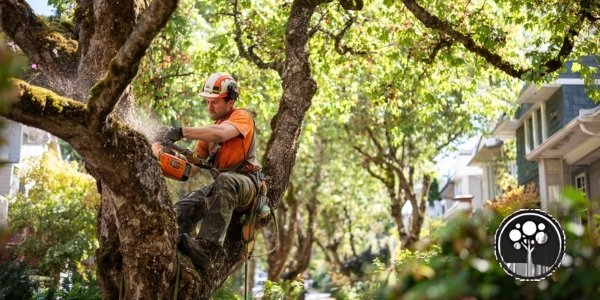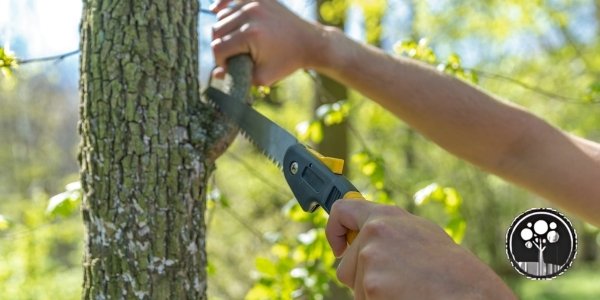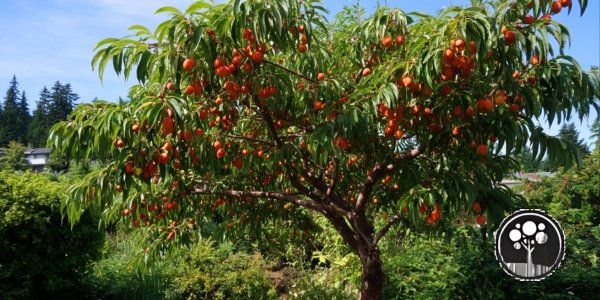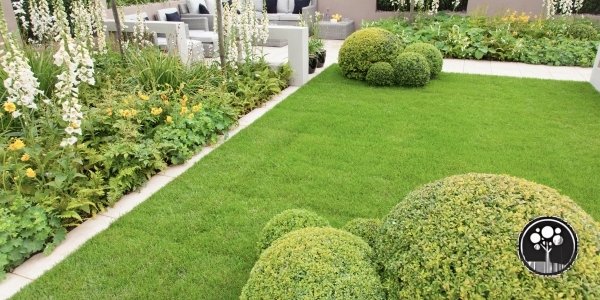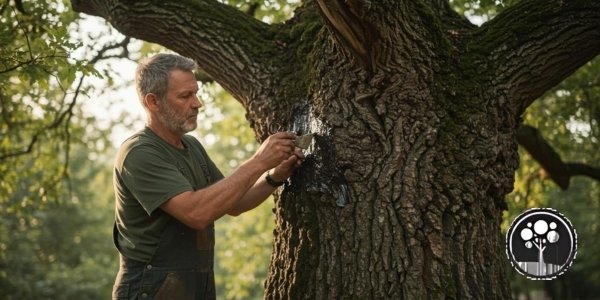Vancouver neighborhood in 2050 will be like this: tree canopy lined the streets providing natural air conditioning during summer heat waves, your property value boosted by lush canopy coverage, and your energy bills reduced by strategic shade placement around your home or business. This vision isn’t wishful thinking—it’s the reality Vancouver City Council is actively creating through the most ambitious urban forestry initiative in the city’s history.
Vancouver’s updated Urban Forest Strategy officially launched with a bold commitment: achieve 30% tree canopy coverage across the city by 2050, up from the previous target of just 22%. This isn’t simply an environmental gesture—it’s a comprehensive economic and social strategy that’s already creating tangible opportunities for property owners who understand how to participate.
Whether you’re a homeowner looking to increase property value, a business owner seeking to reduce operating costs and enhance customer appeal, or an investor considering Vancouver’s long-term growth potential, these seven key elements of the Urban Forest Strategy will directly impact your decisions and opportunities over the next 25 years.
The 30% Tree Canopy Goal: From Aspiration to Action Plan
Vancouver’s commitment to reaching 30% tree canopy coverage by 2050 represents one of the most ambitious urban forestry targets in North America, but city planners have moved beyond aspirational goals to create detailed implementation strategies that directly benefit property owners who participate early.
The current reality sets the stage. Vancouver’s existing canopy coverage varies dramatically by neighborhood, from less than 10% in some densely developed areas to over 40% in established residential districts like Shaughnessy and Kerrisdale. This disparity isn’t accidental—it reflects decades of development patterns that prioritized density over environmental considerations. The new strategy acknowledges these inequities and creates specific mechanisms to address them.
The implementation approach is sophisticated. Rather than simply planting trees wherever space allows, the city has developed neighborhood-specific plans that consider existing infrastructure, future development patterns, and community needs. Priority areas include neighborhoods with lower current canopy coverage, higher summer temperatures, and less access to green spaces. This targeted approach ensures that tree planting efforts deliver maximum environmental and social benefits.
Property owner participation is essential. Private property holds approximately 60% of Vancouver’s potential tree planting opportunities, making homeowner and business participation crucial to achieving the 30% goal. The city recognizes this reality and has created unprecedented incentive programs to encourage private tree planting and maintenance.
The timeline creates urgency and opportunity. Achieving 30% canopy coverage by 2050 requires planting approximately 150,000 new trees across the city—roughly 6,000 trees per year. This massive undertaking creates opportunities for property owners to participate in city programs, access subsidies and incentives, and position their properties to benefit from increased neighborhood desirability.
Success metrics go beyond tree counting. The strategy includes sophisticated monitoring systems that track not just the number of trees planted, but their survival rates, growth patterns, and environmental benefits. This data-driven approach ensures that investments in urban forestry deliver measurable returns in terms of air quality improvement, temperature reduction, and stormwater management.
The most successful property owners will be those who understand that participating in Vancouver’s urban forest vision positions them advantageously for long-term property value growth and community benefits.
Green Equity Initiative: Targeting Underserved Neighborhoods
Vancouver’s Urban Forest Strategy places unprecedented emphasis on “green equity”—ensuring that all neighborhoods have access to the environmental, health, and economic benefits of tree canopy coverage, regardless of current income levels or development patterns. This focus creates significant opportunities for property owners in previously underserved areas.
The equity framework is data-driven. City planners have mapped canopy coverage against demographic and economic data, revealing stark disparities between neighborhoods. Areas with lower average incomes often have significantly less tree coverage, higher summer temperatures, and greater exposure to air pollution. The new strategy specifically targets these areas for priority tree planting and maintenance support.
Investment follows the equity priorities. The city is allocating disproportionate resources to neighborhoods that have historically received less urban forestry investment. This includes East Vancouver communities, certain areas of South Vancouver, and neighborhoods with high-density rental housing. Property owners in these areas can access enhanced subsidies, free tree programs, and expedited permitting for tree-related improvements.
Gentrification concerns are being addressed proactively. City planners recognize that improving neighborhood tree canopy can contribute to rising property values and potential displacement of existing residents. The strategy includes affordable housing protections and community engagement processes designed to ensure that existing residents benefit from environmental improvements rather than being displaced by them.
Business opportunities are emerging. The focus on green equity creates opportunities for local businesses, particularly those owned by residents of target neighborhoods, to participate in tree planting and maintenance contracts. The city is actively seeking to ensure that urban forestry investments benefit local employment and business development.
Property value implications are significant. Early research suggests that properties in neighborhoods targeted for green equity improvements may experience above-average value appreciation as tree canopy increases and neighborhood desirability improves. Property owners who invest in complementary improvements—such as landscaping that integrates with new street trees—may see enhanced benefits.
Community engagement is authentic. Unlike top-down urban planning approaches, the green equity initiative includes extensive community consultation to ensure that tree planting efforts reflect neighborhood preferences and needs. Residents help select tree species, placement priorities, and complementary improvements that enhance rather than conflict with existing community character.
Free Trees and Subsidies: City Programs That Pay You to Plant
Vancouver’s 2025 Tree Sale and Canopy Restoration Programs represent the most generous municipal tree subsidies in Canadian urban forestry history, providing property owners with direct financial incentives that often cover 70-100% of tree planting and establishment costs while delivering long-term property value benefits.
The 2025 Tree Sale offers unprecedented value. Vancouver residents can purchase high-quality native and adapted tree species at 50-70% below retail cost, with trees specifically selected for local growing conditions and climate resilience. The program includes not just saplings, but mature trees up to 8 feet tall, allowing property owners to achieve immediate visual and environmental impact.
Installation support goes beyond tree provision. The city provides consulting services to help property owners select appropriate species and locations, ensuring success rates and maximizing environmental benefits. Professional arborists offer site visits, soil testing, and planting guidance, services that would typically cost hundreds of dollars per consultation.
The Canopy Restoration Program provides grants for significant projects. Property owners undertaking large-scale tree planting or forest restoration projects can access grants up to $5,000 per project, with additional funding available for projects that demonstrate exceptional environmental or community benefits. These grants can fully cover costs for many residential and small commercial projects.
Maintenance support ensures long-term success. Recognizing that tree establishment requires ongoing care, the city provides subsidized maintenance services for the first three years after planting. This includes watering during dry periods, pruning for healthy development, and pest management—services that significantly improve survival rates while reducing property owner responsibilities.
Species selection prioritizes climate adaptation. All subsidized trees are selected for their ability to thrive in Vancouver’s changing climate conditions, including increased summer heat, variable precipitation patterns, and potential extreme weather events. This ensures that investments in tree planting deliver decades of benefits rather than requiring replacement due to climate stress.
Application processes are streamlined. Online applications, expedited approvals, and coordination with existing permit processes make participation as simple as possible for busy property owners. The city recognizes that bureaucratic complexity can discourage participation and has designed programs with user experience as a priority.
TreeCAP Recognition: Marketing Value for Green Properties
Vancouver’s Tree Canopy Achievement Program (TreeCAP) creates formal recognition for properties that demonstrate exceptional commitment to urban forest goals, providing marketing advantages and potential financial benefits that forward-thinking property owners are already leveraging.
Recognition levels reflect different achievement standards. Bronze recognition acknowledges properties that meet basic tree coverage and care standards, while Silver and Gold levels recognize increasingly exceptional efforts in tree planting, species diversity, maintenance quality, and environmental innovation. Platinum recognition is reserved for properties that serve as demonstration sites for best practices in urban forestry.
Marketing benefits are substantial. TreeCAP-recognized properties receive official certification that can be highlighted in real estate listings, marketing materials, and business communications. Early evidence suggests that certified properties attract environmentally conscious buyers and tenants willing to pay premium prices for demonstrated sustainability commitments.
The certification process is professional and credible. Independent arborists conduct site assessments using standardized criteria that evaluate tree health, species diversity, environmental benefits, and maintenance practices. This third-party verification ensures credibility while providing detailed assessments that help property owners improve their urban forestry practices.
Business applications are expanding rapidly. Commercial properties with TreeCAP certification report enhanced corporate sustainability credentials, improved employee satisfaction, and increased customer loyalty. Restaurants with certified green spaces see higher patio utilization, while office buildings use certification to attract environmentally conscious tenants and command premium lease rates.
Residential benefits extend beyond property values. TreeCAP-certified homes often qualify for reduced home insurance premiums due to decreased wildfire risk and storm damage potential. Some mortgage lenders are beginning to offer preferential rates for properties with verified environmental certifications, recognizing the long-term value protection these features provide.
The renewal process ensures ongoing commitment. TreeCAP certification requires renewal every three years, with updated assessments that reflect tree growth, changing conditions, and evolving best practices. This ongoing process ensures that certified properties maintain high standards while adapting to new knowledge in urban forestry management.
Network effects create additional value. TreeCAP-certified properties become part of a recognized network that shares best practices, coordinates on neighborhood-scale projects, and advocates for supportive municipal policies. This community aspect provides ongoing value beyond individual property benefits.
Climate Resilience Through Strategic Tree Canopy Placement
Vancouver’s Urban Forest Strategy emphasizes “right tree, right place” principles that maximize climate adaptation benefits while creating microclimates that reduce energy costs and enhance property comfort during increasingly frequent extreme weather events.
Heat island reduction is a primary focus. Strategic tree placement can reduce local temperatures by 2-8 degrees Celsius during summer heat waves, a critical benefit as Vancouver experiences more frequent extreme heat events. Trees planted on the south and west sides of buildings provide cooling shade, while those in parking areas and paved surfaces reduce heat reflection and absorption.
Energy savings are measurable and immediate. Properly placed shade trees can reduce residential cooling costs by 15-35% during summer months, while evergreen windbreaks can reduce heating costs by 10-25% during winter. These savings compound over time, often covering tree planting and maintenance costs within 5-10 years while providing decades of additional benefits.
Wind protection strategies address Vancouver’s storm patterns. The strategy includes guidance for using trees to create windbreaks that protect buildings from storm damage while avoiding species and placements that could increase risk during high-wind events. This balanced approach enhances property protection while supporting urban forest goals.
Stormwater management benefits reduce flood risk. Strategically placed trees intercept rainfall, reduce surface runoff, and help prevent basement flooding and property damage during Vancouver’s increasingly intense storm events. Properties with comprehensive tree coverage often experience less water damage and lower insurance claims related to storm events.
Air quality improvements provide health benefits. Trees strategically placed to intercept prevailing winds can significantly reduce air pollution exposure for residential and commercial properties. This is particularly valuable near busy streets, industrial areas, or other pollution sources, potentially providing measurable health benefits for occupants.
Soil protection prevents erosion and foundation issues. Tree root systems stabilize soil and reduce erosion that can threaten building foundations, retaining walls, and landscaping investments. This protective benefit is particularly valuable on sloped sites or areas with challenging soil conditions.
Professional arborist consultation ensures that tree placement decisions optimize these climate resilience benefits while avoiding potential conflicts with utilities, structures, or future property development plans.
Professional Arborist Services: The Key to Success
Vancouver‘s ambitious urban forestry goals create unprecedented demand for qualified arborist services, making professional tree care expertise more valuable than ever for property owners who want to maximize their investments while contributing to citywide environmental objectives.
Proper species selection requires local expertise. Vancouver’s unique climate conditions, soil types, and urban environment require tree species selection that balances environmental benefits with practical considerations like mature size, root systems, maintenance requirements, and longevity. Professional arborists understand which species thrive in specific microclimates while providing desired benefits.
Site assessment prevents costly mistakes. Professional arborists evaluate soil conditions, drainage patterns, existing vegetation, utility locations, and future maintenance access before recommending tree placement and species selection. This comprehensive assessment prevents problems like root conflicts with foundations, utility interference, or poor growth due to unsuitable site conditions.
Installation expertise ensures survival rates. Proper planting techniques, including soil preparation, root treatment, staking methods, and initial watering protocols, significantly impact tree survival and growth rates. Professional installation typically achieves 90%+ survival rates compared to 60-70% for amateur planting efforts, making professional services cost-effective over time.
Ongoing maintenance maximizes benefits. Professional pruning, fertilization, pest management, and health monitoring help trees reach their full potential while preventing problems that could require expensive intervention or tree removal. Regular professional care often extends tree canopy lifespans by decades while maintaining optimal environmental benefits.
Integration with city programs requires knowledge. Professional arborists understand Vancouver’s various tree programs, permitting requirements, and incentive opportunities, helping property owners navigate bureaucratic processes while maximizing available subsidies and support. This expertise can save property owners significant time and money while ensuring compliance with municipal requirements.
Emergency services protect property investments. When storms, disease, or other problems threaten trees, professional arborists can quickly assess situations and implement solutions that protect both trees and property. Emergency tree services can prevent minor problems from becoming major property damage or safety hazards.
Property Value Impact: The Financial Case for Tree Canopy
Research consistently demonstrates that strategic tree planting and maintenance delivers measurable property value increases that often exceed investment costs within 5-10 years while providing ongoing benefits that compound over decades.
Residential property values increase measurably. Studies specific to Vancouver’s market show that mature tree coverage can increase residential property values by 7-15%, with larger impacts in neighborhoods where tree coverage is currently limited. A single mature tree in an optimal location can add $1,500-$3,000 to property value immediately, with continued appreciation as the tree grows.
Commercial properties see enhanced leasing and sales metrics. Commercial properties with quality landscaping and tree coverage lease faster, command higher rents, and experience lower tenant turnover compared to properties without green features. Retail locations with attractive tree coverage report higher foot traffic and customer dwell times.
Energy cost savings provide ongoing returns. Beyond initial property value increases, strategic tree placement delivers ongoing energy savings that improve property cash flow. These savings become more valuable over time as energy costs increase and as trees mature to provide greater cooling and wind protection benefits.
Insurance benefits reduce operating costs. Properties with mature tree coverage often qualify for reduced insurance premiums due to decreased fire risk, storm damage protection, and overall property protection. Some insurers offer specific discounts for properties that demonstrate comprehensive landscape risk management.
Market differentiation creates competitive advantages. As Vancouver’s urban forest goals gain prominence and environmental consciousness influences buying decisions, properties with demonstrated tree stewardship and environmental benefits enjoy competitive advantages in both sales and rental markets.
Long-term appreciation patterns favor green properties. Historical data suggests that properties with established landscaping and tree coverage appreciate more consistently and recover faster from market downturns compared to properties without green features. This stability makes tree investments particularly valuable for long-term property owners.
The key to maximizing these financial benefits lies in working with experienced professionals who understand both urban forestry best practices and Vancouver’s specific market conditions, ensuring that tree investments align with property goals and market expectations.
The Implementation Timeline: Getting Started in 2025 Tree Canopy
Vancouver’s 2025 tree programs and incentives create time-sensitive opportunities that reward early participation while supporting the city’s long-term canopy goals. Understanding implementation timelines helps property owners make strategic decisions about when and how to participate.
Fall 2025 represents optimal planting timing. Vancouver’s climate makes fall the ideal season for tree canopy establishment, allowing roots to develop during mild, wet winter months before facing summer heat stress. Property owners planning to participate in city programs should begin planning and application processes in late summer to ensure fall planting opportunities.
Program enrollment periods have specific deadlines. The 2025 Tree Sale registration opens in September with limited quantities allocated on a first-come, first-served basis. TreeCAP certification applications are accepted year-round, but assessments are scheduled primarily during growing season months when tree canopy health and growth patterns are most apparent.
Grant application cycles align with city budget processes. Major grant programs typically open applications in early fall for the following year’s projects. Property owners considering larger tree canopy planting projects should plan application timelines around these cycles to ensure funding availability and optimal planting schedules.
Permit processes require advance planning. While Vancouver has streamlined tree-related permits, major projects may require 4-8 weeks for approval and coordination with utility companies. Property owners should factor permit timelines into project planning to avoid delays that might affect optimal planting windows.
Professional service scheduling fills early. Qualified arborist services experience high demand during optimal planting seasons. Property owners serious about participating in 2025 programs should arrange professional consultations and service agreements well in advance to ensure availability during preferred timing windows.
The most successful property owners will be those who begin planning immediately, taking advantage of professional consultation services to develop comprehensive strategies that align with Vancouver’s urban forest goals and maximize their return on investment.
Ready to Transform Your Property with Vancouver’s Urban Forest Strategy?
Partner with Aesthetic Tree & Hedge Care—your trusted local arborist experts committed to helping you maximize property value, enhance climate resilience, and contribute to a greener Vancouver.
Contact Us Today for a Free Consultation or call us at 604-721-7370 to get started!
